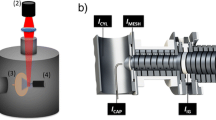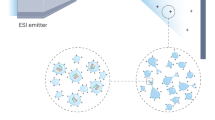Abstract
The achievable sensitivity of electrospray ionization mass spectrometry (ESI-MS) is largely determined by the ionization efficiency in the ESI source and ion transmission efficiency through the ESI-MS interface. These performance characteristics are difficult to evaluate and compare across multiple platforms as it is difficult to correlate electrical current measurements to actual analyte ions reaching the detector of a mass spectrometer. We present an effective method to evaluate the overall ion utilization efficiency of an ESI-MS interface by measuring the total gas-phase ion current transmitted through the interface and correlating it to the observed ion abundance measured in the corresponding mass spectrum. Using this method, we systematically studied the ion transmission and ionization efficiencies of different ESI-MS interface configurations, including a single emitter/single inlet capillary, single emitter/multi-inlet capillary, and a subambient pressure ionization with nanoelectrospray (SPIN) MS interface with a single emitter and an emitter array, respectively. Our experimental results indicate that the overall ion utilization efficiency of SPIN-MS interface configurations exceeds that of the inlet capillary-based ESI-MS interface configurations.

ᅟ




Similar content being viewed by others
References
Fenn, J.B., Mann, M., Meng, C.K., Wong, S.F., Whitehouse, C.M.: Electrospray ionization for mass-spectrometry of large biomolecules. Science 246, 64–71 (1989)
Smith, R. D., Loo, J. A., Loo, R. R. O., Busman, M., Udseth, H. R.: Principles and practice of electrospray ionization - mass-spectrometry for large polypeptides and proteins. Mass Spectrometry Reviews 10, 359–451 (1991)
Mehlis, B., Kertscher, U.: Liquid chromatography mass spectrometry of peptides of biological samples. Anal. Chim. Acta. 352, 71–83 (1997)
Shen, Y., Tolić, N., Masselon, C., Paša-Tolić, L., Camp, D.G., Hixson, K.K., Zhao, R., Anderson, G.A., Smith, R.D.: Ultrasensitive proteomics using high-efficiency on-line micro-SPE-nanoLC-nanoESI MS and MS/MS. Anal. Chem. 76, 144–154 (2003)
Wilm, M., Mann, M.: Analytical properties of the nanoelectrospray ion source. Anal. Chem. 68, 1–8 (1996)
El-Faramawy, A., Siu, K.W.M., Thomson, B.A.: Efficiency of nano-electrospray ionization. J. Am. Soc. Mass Spectrom. 16, 1702–1707 (2005)
Schmidt, A., Karas, M., Dulcks, T.: Effect of different solution flow rates on analyte ion signals in nano-esi ms, or: When does ESI turn into nano-ESI? J. Am. Soc. Mass Spectrom. 14, 492–500 (2003)
Lin, B.W., Sunner, J.: Ion-transport by viscous-gas flow-through capillaries. J. Am. Soc. Mass Spectrom. 5, 873–885 (1994)
Page, J.S., Kelly, R.T., Tang, K., Smith, R.D.: Ionization and transmission efficiency in an electrospray ionization-mass spectrometry interface. J. Am. Soc. Mass Spectrom. 18, 1582–1590 (2007)
Kebarle, P., Tang, L.: From ions in solution to ions in the gas phase—the mechanism of electrospray mass-spectrometry. Anal. Chem. 65, A972–A986 (1993)
Kebarle, P.: A brief overview of the present status of the mechanisms involved in electrospray mass spectrometry. J. Mass Spectrom. 35, 804–817 (2000)
Bruins, A.P.: Mechanistic aspects of electrospray ionization. J. Chromatogr. A 794, 345–357 (1998)
Konermann, L., Ahadi, E., Rodriguez, A.D., Vahidi, S.: Unraveling the mechanism of electrospray ionization. Anal. Chem. 85, 2–9 (2012)
Marginean, I., Kelly, R.T., Prior, D.C., LaMarche, B.L., Tang, K., Smith, R.D.: Analytical characterization of the electrospray ion source in the nanoflow regime. Anal. Chem. 80, 6573–6579 (2008)
Heemskerk, A.A.M., Busnel, J.-M., Schoenmaker, B., Derks, R.J.E., Klychnikov, O., Hensbergen, P.J., Deelder, A.M., Mayboroda, O.A.: Ultra-low flow electrospray ionization-mass spectrometry for improved ionization efficiency in phosphoproteomics. Anal. Chem. 84, 4552–4559 (2012)
Marginean, I., Tang, K., Smith, R.D., Kelly, R.T.: Picoelectrospray ionization mass spectrometry using narrow-bore chemically etched emitters. J. Am. Soc. Mass Spectrom. 25, 30–36 (2014)
Tang, K.Q., Lin, Y.H., Matson, D.W., Kim, T., Smith, R.D.: Generation of multiple electrosprays using microfabricated emitter arrays for improved mass spectrometric sensitivity. Anal. Chem. 73, 1658–1663 (2001)
Su, S., Gibson, G.T.T., Mugo, S.M., Marecak, D.M., Oleschuk, R.D.: Microstructured photonic fibers as multichannel electrospray emitters. Anal. Chem. 81, 7281–7287 (2009)
Gibson, G.T.T., Mugo, S.M., Oleschuk, R.D.: Nanoelectrospray emitters: trends and perspective. Mass Spectrom. Rev. 28, 918–936 (2009)
Wu, X., Oleschuk, R.D., Cann, N.M.: Characterization of microstructured fibre emitters: In pursuit of improved nano electrospray ionization performance. Analyst 137, 4150–4161 (2012)
Kelly, R.T., Page, J.S., Marginean, I., Tang, K., Smith, R.D.: Nanoelectrospray emitter arrays providing interemitter electric field uniformity. Anal. Chem. 80, 5660–5665 (2008)
Kim, W., Guo, M., Yang, P., Wang, D.: Microfabricated monolithic multinozzle emitters for nanoelectrospray mass spectrometry. Anal. Chem. 79, 3703–3707 (2007)
Mao, P., Wang, H.-T., Yang, P., Wang, D.: Multinozzle emitter arrays for nanoelectrospray mass spectrometry. Anal. Chem. 83, 6082–6089 (2011)
Schneider, B.B., Javaheri, H., Covey, T.R.: Ion sampling effects under conditions of total solvent consumption. Rapid Commun. Mass Spectrom. 20, 1538–1544 (2006)
Manisali, I., Chen, D.D.Y., Schneider, B.B.: Electrospray ionization source geometry for mass spectrometry: past, present, and future. Trac-Trends Anal. Chem. 25, 243–256 (2006)
Pagnotti, V.S., Inutan, E.D., Marshall, D.D., McEwen, C.N., Trimpin, S.: Inlet ionization: a new highly sensitive approach for liquid chromatography/mass spectrometry of small and large molecules. Anal. Chem. 83, 7591–7594 (2011)
Wang, B., Inutan, E., Trimpin, S.: A new approach to high sensitivity liquid chromatography-mass spectrometry of peptides using nanoflow solvent assisted inlet ionization. J. Am. Soc. Mass Spectrom. 23, 442–445 (2012)
Pagnotti, V.S., Chubatyi, N.D., McEwen, C.N.: Solvent assisted inlet ionization: an ultrasensitive new liquid introduction ionization method for mass spectrometry. Anal. Chem. 83, 3981–3985 (2011)
Pagnotti, V.S., Chakrabarty, S., Harron, A.F., McEwen, C.N.: Increasing the sensitivity of liquid introduction mass spectrometry by combining electrospray ionization and solvent assisted inlet ionization. Anal. Chem. 84, 6828–6832 (2012)
Page, J.S., Tang, K., Kelly, R.T., Smith, R.D.: Subambient pressure ionization with nanoelectrospray source and interface for improved sensitivity in mass spectrometry. Anal. Chem. 80, 1800–1805 (2008)
Marginean, I., Page, J.S., Tolmachev, A.V., Tang, K., Smith, R.D.: Achieving 50% ionization efficiency in subambient pressure ionization with nanoelectrospray. Anal. Chem. 82, 9344–9349 (2010)
Pauly, M., Sroka, M., Reiss, J., Rinke, G., Albarghash, A., Vogelgesang, R., Hahne, R., Kuster, B., Sesterhenn, J., Kern, K., Rauschenbach, S.: A Hydrodynamically optimized nano-electrospray ionization source and vacuum interface. Analyst 139, 1856–1867 (2014)
Cox, J.T., Marginean, I., Kelly, R.T., Smith, R.D., Tang, K.: Improving the sensitivity of mass spectrometry by using a new sheath flow electrospray emitter array at subambient pressures. J. Am. Soc, Mass Spectrom (2014). doi:10.1007/s13361-014-0856-5
Kelly, R.T., Page, J.S., Luo, Q., Moore, R.J., Orton, D.J., Tang, K., Smith, R.D.: Chemically etched open tubular and monolithic emitters for nanoelectrospray ionization mass spectrometry. Anal. Chem. 78, 7796–7801 (2006)
Cech, N.B., Enke, C.G.: Practical implications of some recent studies in electrospray ionization fundamentals. Mass Spectrom. Rev. 20, 362–387 (2001)
Tang, X., Bruce, J.E., Hill Jr., H.H.: Characterizing electrospray ionization using atmospheric pressure ion mobility spectrometry. Anal. Chem. 78, 7751–7760 (2006)
Tang, K.Q., Page, J.S., Smith, R.D.: Charge competition and the linear dynamic range of detection in electrospray ionization mass spectrometry. J. Am. Soc. Mass Spectrom. 15, 1416–1423 (2004)
Acknowledgments
The authors thank Dr. Ryan T. Kelly and Dr. Yehia Ibrahim for useful discussions. Portions of this research were supported by the NIH National Cancer Institute (1R33CA155252) and General Medical Sciences (GM103493-12), the Laboratory Directed Research and Development Program at Pacific Northwest National Laboratory (PNNL), and the Department of Energy Office of Biological and Environmental Research Genome Sciences Program under the Pan-omics project. All the experiments were performed in the Environmental Molecular Sciences Laboratory, a US Department of Energy (DOE) national scientific user facility located at PNNL in Richland, Washington. PNNL is a multiprogramming national laboratory operated by Battelle for the DOE under contract DE-AC05-76RLO01830.
Author information
Authors and Affiliations
Corresponding author
Rights and permissions
About this article
Cite this article
Cox, J.T., Marginean, I., Smith, R.D. et al. On the Ionization and Ion Transmission Efficiencies of Different ESI-MS Interfaces. J. Am. Soc. Mass Spectrom. 26, 55–62 (2015). https://doi.org/10.1007/s13361-014-0998-5
Received:
Revised:
Accepted:
Published:
Issue Date:
DOI: https://doi.org/10.1007/s13361-014-0998-5




